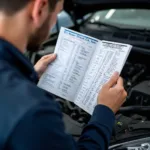Understanding OBD2 engine performance wiring diagrams is crucial for diagnosing and fixing car problems. These diagrams provide a roadmap of your vehicle’s electrical system, specifically focusing on the components that influence engine performance. This guide delves into the complexities of these diagrams, equipping you with the knowledge to interpret them effectively.
Decoding OBD2 Engine Performance Wiring Diagrams
OBD2, or On-Board Diagnostics II, is a standardized system that allows you to access your vehicle’s diagnostic data. This data, when interpreted correctly with the help of wiring diagrams, can pinpoint the root cause of engine performance issues. Wiring diagrams are visual representations of the electrical circuits in your vehicle, showing how various components are connected. They can be incredibly useful for troubleshooting problems related to sensors, actuators, and the ECU (Engine Control Unit).
Why are OBD2 Engine Performance Wiring Diagrams Important?
These diagrams are essential for anyone working on car electronics, from professional mechanics to DIY enthusiasts. They allow you to trace the flow of electricity, identify faulty components, and understand the complex interactions within the engine management system. Without them, diagnosing issues would be like navigating a maze in the dark.
Understanding the different symbols and abbreviations used in these diagrams is the first step towards effective interpretation. Common symbols include those for grounds, connectors, fuses, and relays. Learning these symbols will help you understand the function of each component and its role in the overall engine performance.
Utilizing OBD2 Engine Performance Wiring Diagrams for Troubleshooting
When your car’s “check engine” light illuminates, it’s a sign that something isn’t right. An OBD2 scanner can retrieve trouble codes, which point to specific areas within the system. By using these codes in conjunction with the relevant wiring diagrams, you can quickly narrow down the potential culprits. For instance, a code related to the oxygen sensor might lead you to the corresponding section of the wiring diagram, allowing you to inspect the wiring, connections, and the sensor itself for any faults.
Different manufacturers use different wiring diagram formats, so familiarizing yourself with the specific format for your vehicle is crucial. Resources like online service manuals and repair databases can be invaluable for finding these diagrams.
Where to Find OBD2 Engine Performance Wiring Diagrams
Finding the correct wiring diagrams can be a challenge. Luckily, numerous resources are available. Online forums, repair manuals, and even manufacturer websites often provide access to these diagrams.
Tips for Reading OBD2 Engine Performance Wiring Diagrams
- Identify the components: Locate the components involved in the specific system you are troubleshooting.
- Trace the wires: Follow the wires connecting these components to understand their relationship.
- Check for power and ground: Verify that the components are receiving the necessary power and ground connections.
- Use a multimeter: Test the continuity of the wires and the operation of the components using a multimeter.
“A good understanding of wiring diagrams is like having x-ray vision for your car’s electrical system,” says John Stevenson, a seasoned automotive engineer. “It allows you to see the hidden connections and understand how everything works together.”
obd2 engine and harness in obd1
Conclusion
OBD2 engine performance wiring diagrams are indispensable tools for diagnosing and resolving car problems. They provide a detailed roadmap of your vehicle’s electrical system, enabling you to pinpoint issues effectively. By learning how to interpret these diagrams, you can save time and money on repairs, and gain a deeper understanding of your car’s intricate workings. Remember, having the right knowledge and resources is key to keeping your engine running smoothly.
FAQ
-
What is an OBD2 wiring diagram? An OBD2 wiring diagram is a visual representation of your vehicle’s electrical system, including the engine control unit, sensors, and actuators.
-
Where can I find OBD2 wiring diagrams? You can find OBD2 wiring diagrams online, in repair manuals, and sometimes on manufacturer websites.
-
How do I read an OBD2 wiring diagram? Learn the symbols, trace the wires, and use a multimeter to test components.
-
Why are OBD2 wiring diagrams important for engine performance? They help pinpoint the cause of performance issues by showing the electrical connections within the engine management system.
-
Can I use any OBD2 wiring diagram for my car? No, use diagrams specific to your vehicle’s make, model, and year.
-
Are OBD2 wiring diagrams only for professionals? No, anyone interested in car repair or diagnostics can learn to use them.
-
What tools do I need to use with OBD2 wiring diagrams? A multimeter is essential for testing circuits and components.
“Accurate diagnosis is the cornerstone of effective car repair,” adds Maria Sanchez, a certified automotive technician. “Wiring diagrams provide the detailed information needed to make those accurate diagnoses.”
For further assistance, please contact us via WhatsApp: +1(641)206-8880, Email: [email protected] or visit us at 789 Elm Street, San Francisco, CA 94102, USA. We offer 24/7 customer support.


